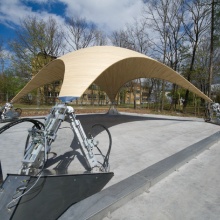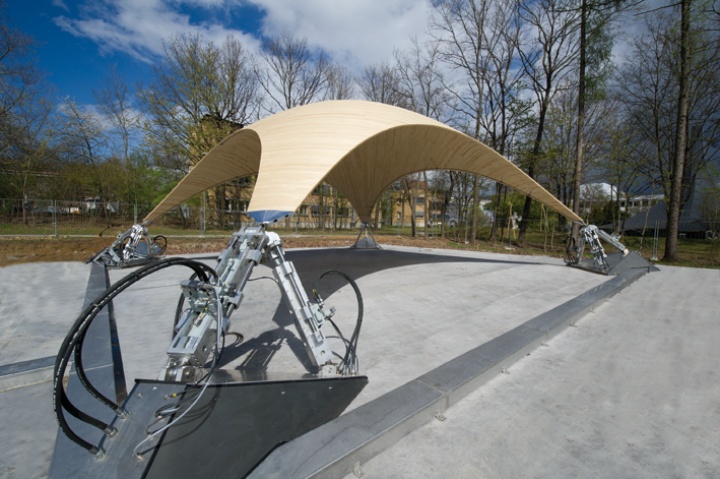On 18 th November 2016 Deutsche Forschungsgemeinschaft (DFG) (German Research Foundation) approved a new special research field (SFB) being established at the University of Stuttgart. The SFB 1244 called “Adaptive Shells and Structures for the built environment of tomorrow“ investigates the question of how more living space can be created in future with less material in view of a growing world population and dwindling resources. Spokesperson is Professor Werner Sobek from the Institut für Leichtbau Entwerfen und Konstruieren (ILEK) (Institute for Lightweight Structures and Conceptual Design). In addition the University of Stuttgart is involved in three projects at the new special research field CAMPOS (Head Institute, University of Tübingen). On 11 th November the DFG had also already approved the new graduate college “Soft Tissue Robotics”.
The Rector of the University of Stuttgart, Professor Wolfram Ressel, stressed: “With the new SFB 1244 the University of Stuttgart has now been able to recruit a special research field for the second time in two years – after the Transregio “Biological Design and Integrative Structures“ -, that focuses on adaptable and simultaneously ecologically efficient structures for buildings of tomorrow. This underlines the research strengths at the University of Stuttgart as its special focus “Architecture and adaptive construction“, that breaks through the boundaries of conventional construction and makes important contributions to preserve the world’s resources.”
The spokesperson of the new special research field, Professor Werner Sobek, added: “The use of adaptive elements allows savings in the application of material and energy in dimensions unknown up to now. With this the SFB 1244 reveals ways with which the construction sector is able to make an important contribution to urgent ecological and economical questions of our time.“
Construction work accounts for around 60 percent of the world’s resource consumption, 50 percent of the mass waste generation as well as 35 percent respectively of energy consumption and emissions. These figures are expected to increase even further if we consider that around two billion of the currently 7.4 billion people on earth are younger than 16 years of age. Building apartments, creating workplaces and infrastructures for this population group in itself requires duplicating the entire number of buildings that existed worldwide in 1930 over the next 16 years. Constructing such a large volume of buildings in such a short period of time is not possible using conventional methods without creating grave consequences for our planets. Therefore new approaches are urgently called for enabling more to be built with less material – and enabling the material consumed to be returned again fully to the natural or technical material cycles.
The new special research field 1244 is researching a solution approach with the use of adaptive elements in supporting structures, shell systems and interior fittings. Such elements enable the structure and physical properties of materials and structural elements to be changed in such a targeted way that these always adapt ideally to different loads. This offers several advantages: supporting structures can be manufactured this way with less material and energy use. In the field of the building shell adaptive elements promote energy efficiency and lead to a clearly improved quality of stay in the buildings themselves – important prerequisites for increasing the physical and mental wellbeing of the users. Along with the relevant static-constructive and the physical effects and opportunities, the integration of adaptive elements also opens up a widened design and creative leeway for the architecture itself.
Fundamental enhancement of architecture
A fundamentally new aspect here is the fact that a building with adaptive qualities no longer has to be seen – as was the case up to now – as a self-contained and finished product. The users can adapt certain properties of the building in a targeted way to suite their requirements. This opens up the transition from the known building up to now to the architectural environment.
The integration of adaptive elements in supporting structures, shell systems and interior fittings means an increase in the number of disciplines involved in the planning process with an increase in interdependencies and correlations of individual planning contents and processes at the same time. In order to meet these requirements, the SFB 1244 will merge planning contents and methods from mechanical engineering, architecture, aircraft construction and civil engineering. It builds on skills in the fields of lightweight constructions, component development, system dynamics, planning theory, visual analysis and design.
Co-participation in the special research field Campos
Furthermore, Professor Wolfgang Nowak from the University of Stuttgart is involved with three sub-projects in the special research field “CAMPOS – materials turnover in catchment areas: metabolisation of pollutants on the landscape scale” (spokesperson Profession Peter Grathwohl, University of Tübingen), likewise approved in the same meeting. The SFB investigates the transport and turnover of pollutants in the large-scale and long-term process chains, as they are prevalent in nature. It does this with the aid of innovative observation systems as well as numerical landscape models and would like to create in this way the basis for more reliable predications about future ground and water quality under the terms of climate and land use change. Special attention is paid to landscape elements such as rivers, sub-zones in the source area of rivers, valley floors, fractured aquifers and soils. The contributions by the University of Stuttgart lie in the field of the optimum planning of experiments as well in the estimation of uncertainties that are avoidable in the modelling and simulation of complex and to date poorly understood processes during the transport of pollutants.
Contact:
Professor Dr. Werner Sobek, University of Stuttgart, Institut für Leichtbau Konstruieren und Entwerfen (ILEK) (Institute for Lightweight Structures and Conceptual Design), Tel. +49 (0)711 685 6 62 26, email:
werner.sobek(at)ilek.uni-stuttgart.de, http://www.uni-stuttgart.de/ilek/
Professor Wolfgang Nowak, Institut für Wasser- und Umweltsystemmodellierung, Stochastische Simulation und Sicherheitsforschung für Hydrosysteme (Institute for Water and Environment System Modelling, Stochastic Simulation and Security Research for Hydro-Systems), Tel. +49-711-685 60113, E-Mail: Wolfgang.Nowak@iws.uni-stuttgart.de



